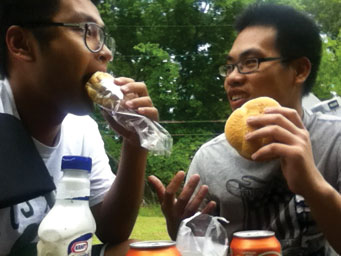International students often struggle with adjusting to American diets
April 19, 2012
For Nigerian student Kehinde Ogebule, America was a land of promise, new experiences and fast food.
“The first thing I rushed for was hamburgers, pizza and things like that,” she said. “But that’s not healthy.”
She said one of the hardest parts of coming to America was adjusting to the change in diet.
“The challenge we face as international students when we come to America (is that) there’s a variety of foods we have to choose in order to stay healthy,” she said.
Many times, international students feel overwhelmed by the variety of foods offered here, and that can cause them to opt for the easy option of relying on fast food and Towers Cafeteria, Ogebule said.
Her situation is not an uncommon one.
Cem Demir, resident dining manager, faced similar troubles when he first came to UNA from Turkey in 1997. He said the students are ill informed about diet changes prior to their arrival in America.
“I used to be in the same boat,” Demir said. “Nobody told me, and I don’t think anybody tells them. When I first came to the U.S. in ’97, I used to be 160 pounds. I went up to 245 (pounds).
“The first two weeks are, I think, the most challenging time.”
Tren Chao, a graduate student from China, agrees.
“In the first days, it was good to try those foods (fast food and pizza),” Chao said. “It would be expensive to eat that (in China). After one week or two, we were kind of tired of the food.”
After gaining 20 pounds, Chao decided to shape up.
“I can’t do this,” he said. “I need to control (my diet).”
Peggy Bergeron, senior nurse for University Health Services, gets visits from international students and believes the problem is both social and physical.
“I think students start out eating at Taco Bell,” Bergeron said. “It’s that freedom thing. It usually takes a semester to realize. That’s across the board—international or not.”
Whereas Demir and Chao said it’s about a two-week adjustment period, Bergeron suggests a wider window.
“Among the international students, they have problems in the first two to three months,” she said.
Coordinator of International Studies Joy Mallard has noticed the trends shortly after students’ arrivals.
“Diet concerns in the first few weeks are a big issue,” she said. “It’s a huge adjustment. It’s a big form of culture shock.”
Overcoming that culture shock, however, is one of the processes necessary for truly embracing a culture, she said.
The biggest gateway to cultural experience: food.
“One of the best ways to experience a culture is through their food,” Mallard said. “There’s a great opportunity for a lot of cuisine and cultures to emerge.”
Chao uses food as an opportunity to communicate with other students.
“For international students, we should seize the chance for more opportunities for food and experience,” he said. “(Eating) is a very good way to get to know people—to talk to people. It is a great topic to start conversation.”
Demir also agrees a culture is manifested in its food and said students need to be ready for the differences.
“It’s not going to be like mama’s cooking,” he said. “You’re going to learn the language and culture. You need to learn the food too.”
To help introduce international students to new foods, Sodexo takes advantage of its Innovation Station, as well as collaborating with international services to host monthly international nights, which feature food from various countries.
“Sodexo’s been really good about adjusting their menus to reach students on campus,” Mallard said.
Replicating “mama’s cooking,” however, might hit the spot for homesick international students.
“Most (international students) prefer to cook at home,” Ogebule said. “Some international students tend to isolate themselves. You find that they are homesick and they just want food from home.”
The problem then becomes finding familiar, African foods such as cassava, yam and melon seeds, Ogebule said.
“If we’re missing food, we have to go to Huntsville to get it and cook at home,” she said.
Chao agrees that cooking at home is the best alternative.
“We decided to buy cookers and cook our own food,” he said. “I believe that’s the best (way) for international students to eat.”
Bergeron said that might be the healthiest option—physically and mentally.
“Find other international students with kitchens that can cook. That helps them meet people and stay connected to home,” she said.
Ogebule said location, as well as food choice, can contribute to dietary—as well as mood—changes.
“Sometimes it’s an environment thing,” she said. “They do not feel comfortable eating in crowded rooms when they are used to eating at home.”












